Effect of Rest Period Duration between Sets of Repeated Sprint Skating Ability Test on the Skating Ability of Ice Hockey Players
Abstract
:1. Introduction
2. Materials and Methods
2.1. Subjects
2.2. Main Test Procedures
2.2.1. Study Design
2.2.2. Measurement of Body Composition
Skating Multistage Aerobic Test (SMAT) for the Measurement of Maximum Heart Rate and Prediction of VO2max
Warm-up before RSSA-2 and RSSA-3 Tests
Repeated Sprint Skating Ability Test
Speed Decrement (Sdec)
Recording of Heart Rate
Measurement of Blood Lactate Concentration
Rate of Perceived Exertion
2.3. Statistical Analyses
3. Results
3.1. Physical and Physiological Characteristics
3.2. Repeated Sprint Skating Ability Test Performance
3.3. Speed Decrement
3.4. Heart Rate Response
3.5. Rate of Perceived Exertion
3.6. Blood Lactate
4. Discussion
5. Conclusions
Author Contributions
Funding
Institutional Review Board Statement
Informed Consent Statement
Conflicts of Interest
References
- Cox, M.H.; Miles, D.S.; Verde, T.J.; Rhodes, E.C. Applied Physiology of Ice Hockey. Sports Med. 1995, 19, 184–201. [Google Scholar] [CrossRef] [PubMed]
- Green, H.; Bishop, P.; Houston, M.; McKillop, R.; Norman, R.; Stothart, P. Time motion and physiological assessments of ice hockey performance. J. Appl. Physiol. 1976, 40, 159–163. [Google Scholar] [CrossRef] [PubMed]
- Brocherie, F.; Girard, O.; Millet, G.P. Updated analysis of changes in locomotor activities across periods in an international ice hockey game. Biol. Sport 2018, 35, 261–267. [Google Scholar] [CrossRef] [PubMed]
- Peterson, B.J.; Fitzgerald, J.S.; Dietz, C.C.; Ziegler, K.S.; Ingraham, S.J.; Baker, S.E.; Snyder, E.M. Aerobic capacity is associated with improved repeated shift performance in hockey. J. Strength Cond. Res. 2015, 29, 1465–1472. [Google Scholar] [CrossRef] [Green Version]
- Roczniok, R.; Stanula, A.; Gabryś, T.; Szmatlan-Gabryś, U.; Gołaś, A.; Stastny, P. Physical fitness and performance of polish ice-hockey players competing at different sports levels. J. Hum. Kinet. 2016, 50, 201–208. [Google Scholar] [CrossRef] [Green Version]
- Stanula, A.; Roczniok, R.; Maszczyk, A.; Pietraszewski, P.; Zając, A. The role of aerobic capacity in high-intensity intermittent efforts in ice-hockey. Biol. Sport 2014, 31, 193–195. [Google Scholar] [CrossRef] [Green Version]
- Oliver, J.L. Is a fatigue index a worthwhile measure of repeated sprint ability? J. Sci. Med. Sport 2009, 12, 20–23. [Google Scholar] [CrossRef]
- Glaister, M. Multiple sprint work: Physiological responses, mechanisms of fatigue and the influence of aerobic fitness. Sports Med. 2005, 35, 757–777. [Google Scholar] [CrossRef]
- Douglas, A.; Johnston, K.; Baker, J.; Rotondi, M.A.; Jamnik, V.K.; Macpherson, A.K. On-Ice Measures of External Load in Relation to Match Outcome in Elite Female Ice Hockey. Sports 2019, 7, 173. [Google Scholar] [CrossRef] [Green Version]
- Leone, M.; Léger, L.A.; Larivière, G.; Comtois, A.S. An on-ice aerobic maximal multistage shuttle skate test for elite adolescent hockey players. Int. J. Sports Med. 2007, 28, 823–828. [Google Scholar] [CrossRef]
- Allisse, M.; Bui, H.T.; Léger, L.; Comtois, A.-S.; Leone, M. Updating the Skating Multistage Aerobic Test and Correction for Vo2max Prediction Using a New Skating Economy Index in Elite Youth Ice Hockey Players. J. Strength Cond. Res. 2020, 34, 3182–3189. [Google Scholar] [CrossRef] [PubMed]
- McGowan, C.J.; Pyne, D.B.; Thompson, K.G.; Rattray, B. Warm-Up Strategies for Sport and Exercise: Mechanisms and Applications. Sports Med. 2015, 45, 1523–1546. [Google Scholar] [CrossRef] [PubMed]
- Hůlka, K.; Bělka, J.; Cuberek, R.; Schneider, O. Reliability of specific on-ice repeated-sprint ability test for ice-hockey players. Acta Gymnica 2014, 44, 69–75. [Google Scholar] [CrossRef] [Green Version]
- Girard, O.; Mendez-Villanueva, A.; Bishop, D. Repeated-sprint ability part I: Factors contributing to fatigue. Sports Med. 2011, 41, 673–694. [Google Scholar] [CrossRef] [PubMed]
- Borg, G. Psychophysical scaling with applications in physical work and the perception of exertion. Scand. J. Work. Environ. Health 1990, 16, 55–58. [Google Scholar] [CrossRef] [PubMed]
- Hopkins, W.G.; Marshall, S.W.; Batterham, A.M.; Hanin, J. Progressive statistics for studies in sports medicine and exercise science. Med. Sci. Sports Exerc. 2009, 41, 3–13. [Google Scholar] [CrossRef] [Green Version]
- Burr, J.F.; Jamnik, R.K.; Baker, J.; Macpherson, A.; Gledhill, N.; McGuire, E.J. Relationship of physical fitness test results and hockey playing potential in elite-level ice hockey players. J. Strength Cond. Res. 2008, 22, 1535–1543. [Google Scholar] [CrossRef]
- Montgomery, D.L. Physiology of ice hockey. Sports Med. 1988, 5, 99–126. [Google Scholar] [CrossRef]
- Twist, P.; Rhodes, T. Exercise physiology: A physiological analysis of ice hockey positions. Natl. Strength Cond. Assoc. J. 2008, 15, 44–46. [Google Scholar] [CrossRef]
- McGawley, K.; Bishop, D. Anaerobic and aerobic contribution to two, 5 × 6-s repeated-sprint bouts. Coach. Sport Sci. J. 2008, 3, 52. [Google Scholar]
- Parolin, M.L.; Chesley, A.; Matsos, M.P.; Spriet, L.L.; Jones, N.L.; Heigenhauser, G.J.F. Regulation of skeletal muscle glycogen phosphorylase and PDH during maximal intermittent exercise. Am. J. Physiol.-Endocrinol. Metab. 1999, 277, E890–E900. [Google Scholar] [CrossRef]
- Bogdanis, G.C.; Nevill, M.E.; Boobis, L.H.; Lakomy, H.K.; Nevill, A.M. Recovery of power output and muscle metabolites following 30 s of maximal sprint cycling in man. J. Physiol. 1995, 482, 467–480. [Google Scholar] [CrossRef] [PubMed]
- Tomlin, D.L.; Wenger, H.A. The relationship between aerobic fitness and recovery from high intensity intermittent exercise. Sports Med. 2001, 31, 1–11. [Google Scholar] [CrossRef] [PubMed]
- Noonan, B.C. Intragame blood-lactate values during ice hockey and their relationships to commonly used hockey testing protocols. J. Strength Cond. Res. 2010, 24, 2290–2295. [Google Scholar] [CrossRef] [PubMed]
- Gaitanos, G.C.; Williams, C.; Boobis, L.H.; Brooks, S. Human muscle metabolism during intermittent maximal exercise. J. Appl. Physiol. (Bethesda Md. 1985) 1993, 75, 712–719. [Google Scholar] [CrossRef] [Green Version]
- Stanula, A.; Roczniok, R. Game intensity analysis of elite adolescent ice hockey players. J. Hum. Kinet. 2014, 44, 211–221. [Google Scholar] [CrossRef] [PubMed] [Green Version]
- Stanula, A.; Gabryś, T.; Roczniok, R.; Szmatlan-Gabryś, U.; Ozimek, M.; Mostowik, A. Quantification of the demands during an ice-hockey game based on intensity zones determined from the incremental test outcomes. J. Strength Cond. Res. 2016, 30, 176–183. [Google Scholar] [CrossRef] [PubMed]
- Eisenhofer, G.; Kopin, I.J.; Goldstein, D.S. Catecholamine metabolism: A contemporary view with implications for physiology and medicine. Pharmacol. Rev. 2004, 56, 331–349. [Google Scholar] [CrossRef]
- McArdle, W.D.; Foglia, G.F.; Patti, A.V. Telemetered cardiac response to selected running events. J. Appl. Physiol. 1967, 23, 566–570. [Google Scholar] [CrossRef]
- Le Meur, Y.; Buchheit, M.; Aubry, A.; Coutts, A.J.; Hausswirth, C. Assessing Overreaching With Heart-Rate Recovery: What Is the Minimal Exercise Intensity Required? Int. J. Sports Physiol. Perform. 2016, 12, 569–573. [Google Scholar] [CrossRef]
- Lamberts, R.P.; Swart, J.; Noakes, T.D.; Lambert, M.I. A novel submaximal cycle test to monitor fatigue and predict cycling performance. Br. J. Sports Med. 2011, 45, 797–804. [Google Scholar] [CrossRef] [PubMed]
- Eston, R. Use of ratings of perceived exertion in sports. Int. J. Sports Physiol. Perform. 2012, 7, 175–182. [Google Scholar] [CrossRef] [PubMed] [Green Version]
- Gupta, S.; Stanula, A.; Goswami, A. Peak Blood Lactate Concentration and Its Arrival Time Following Different Track Running Events in Under-20 Male Track Athletes. Int. J. Sports Physiol. Perform. 2021, 1–9. [Google Scholar] [CrossRef]
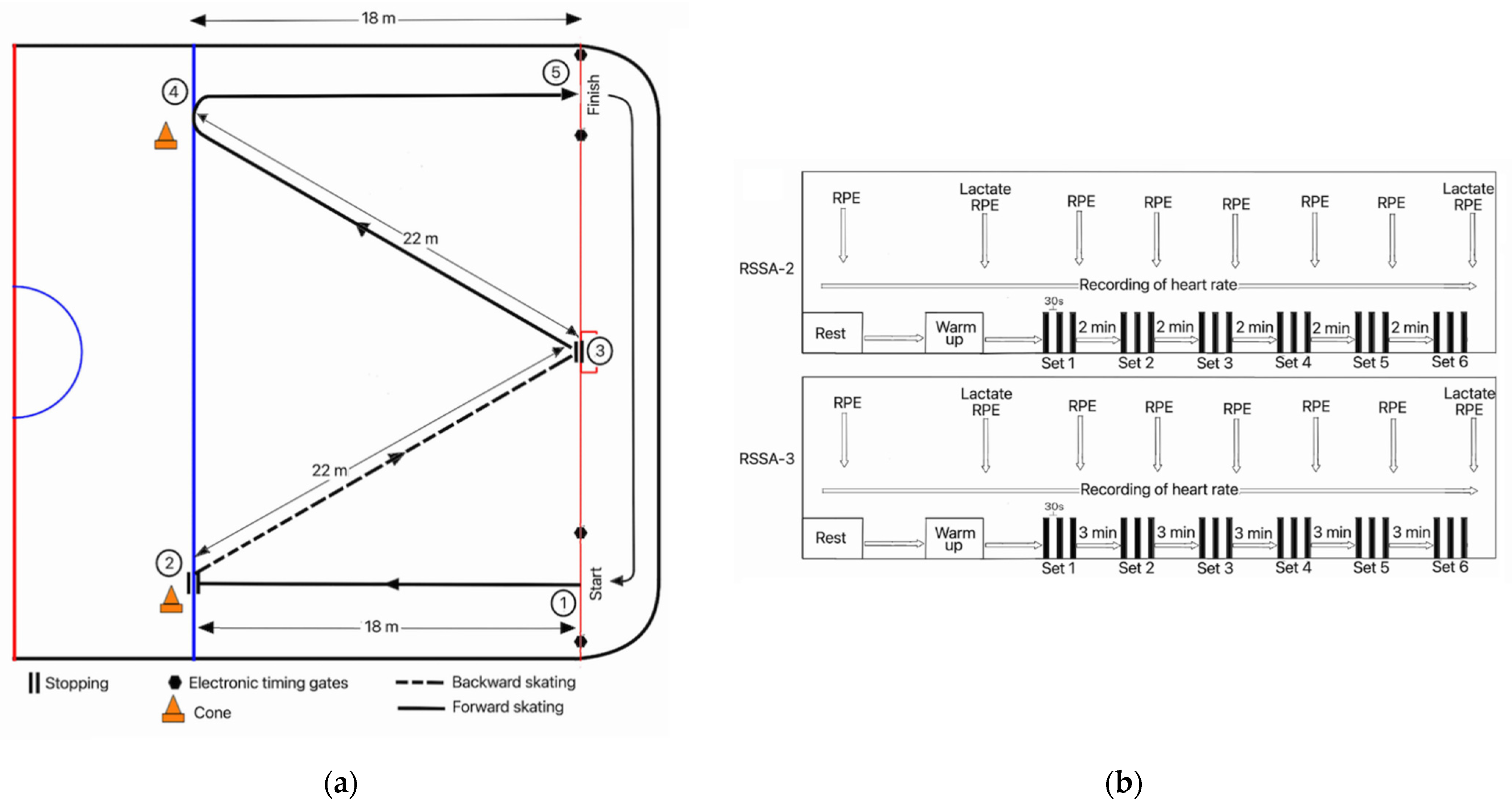
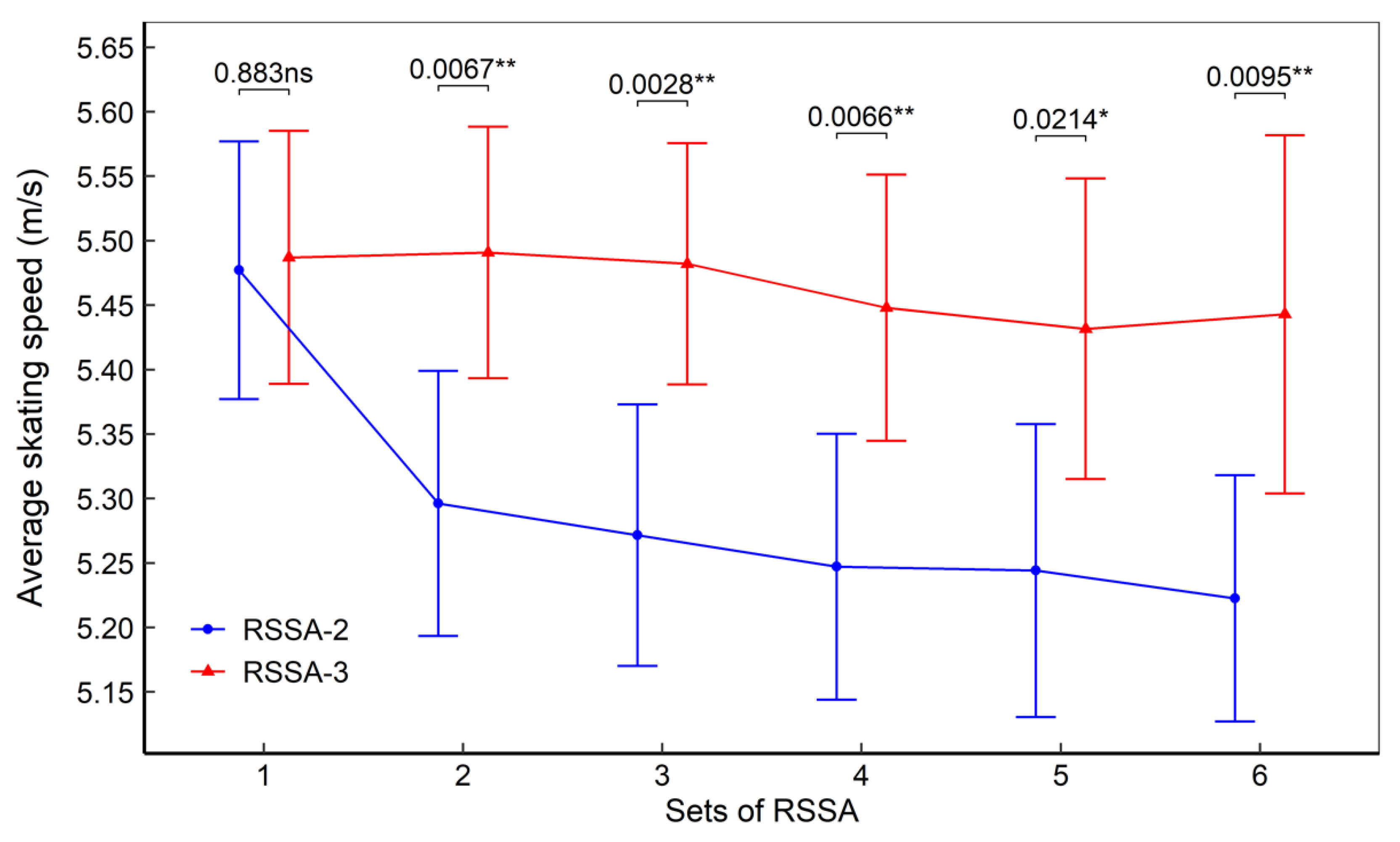

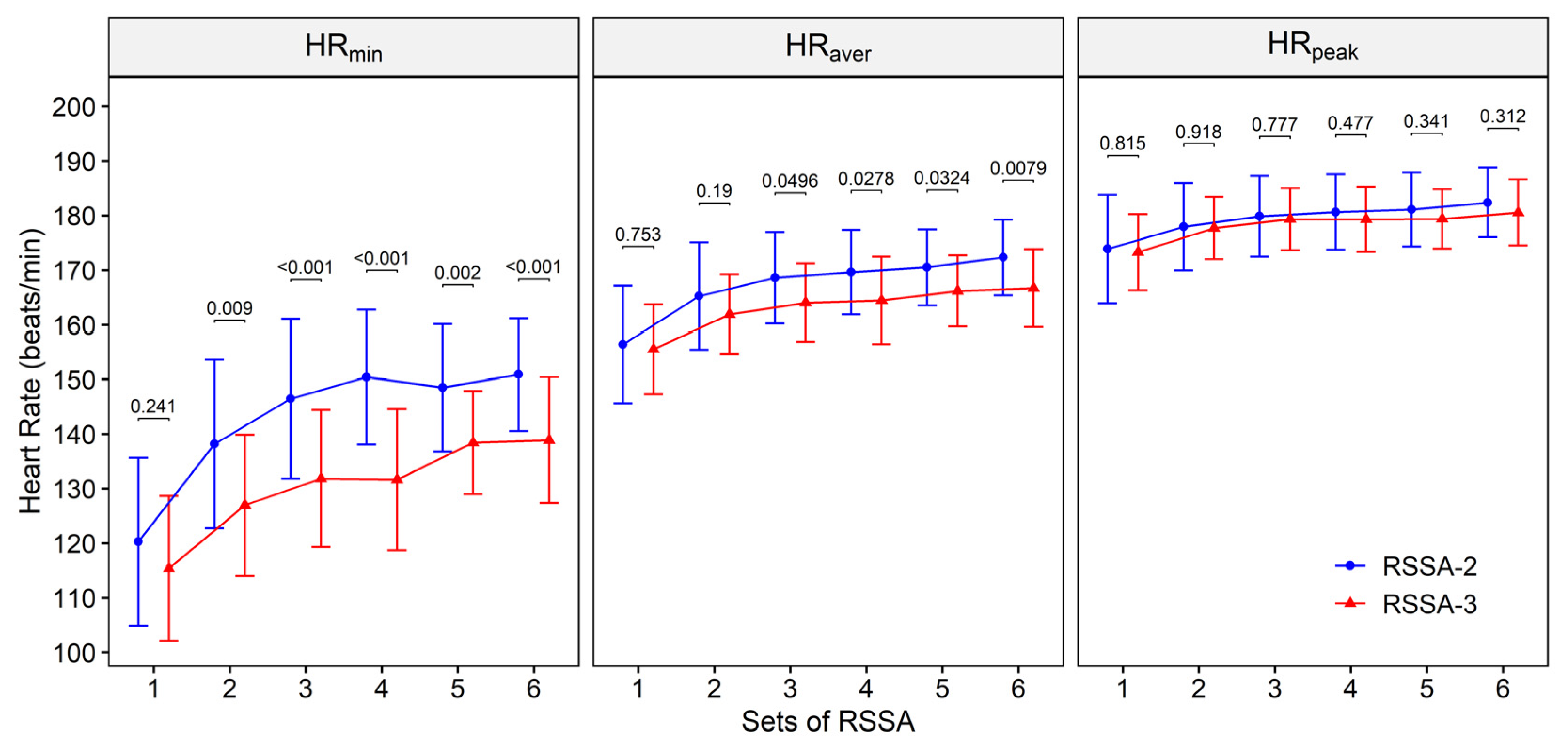
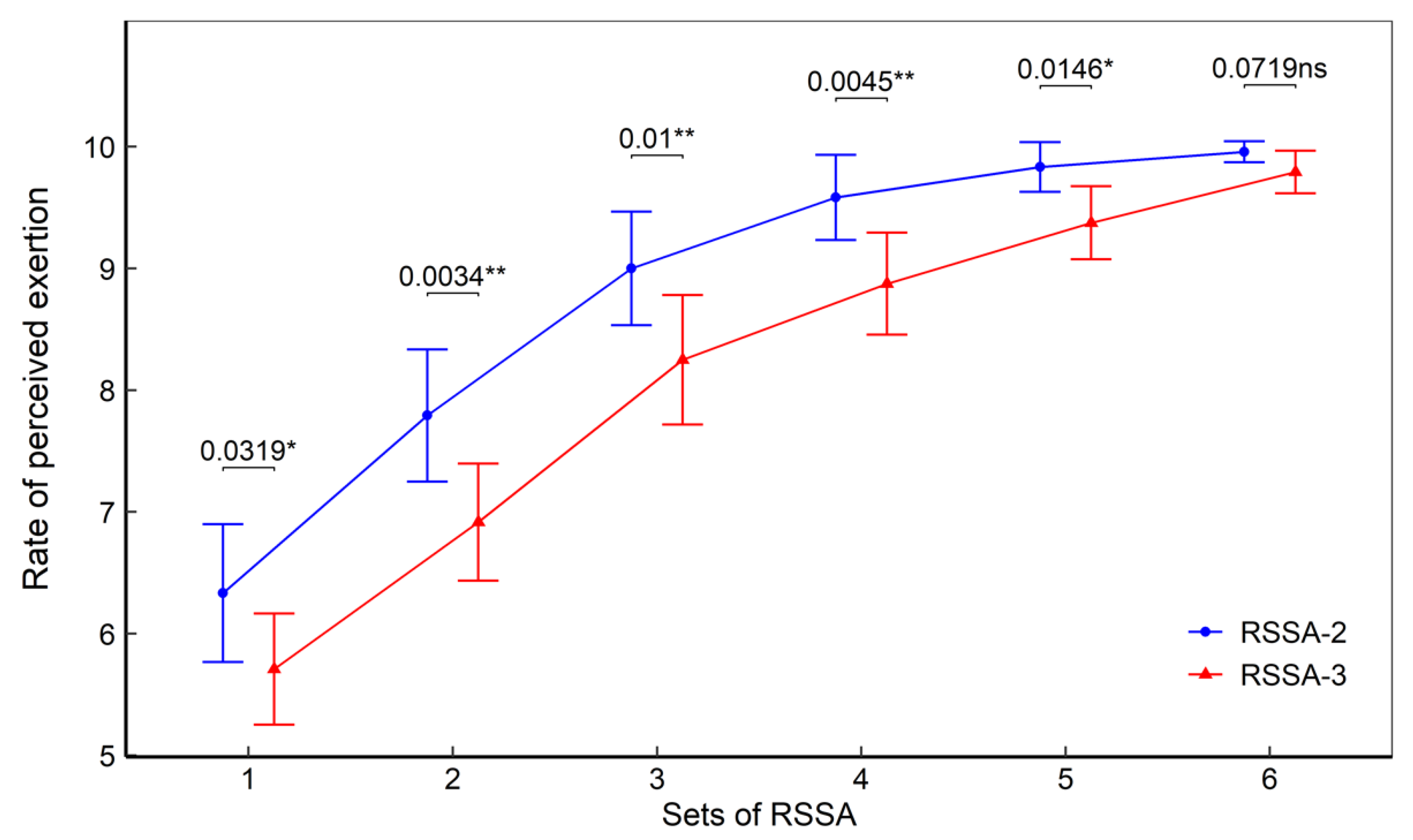
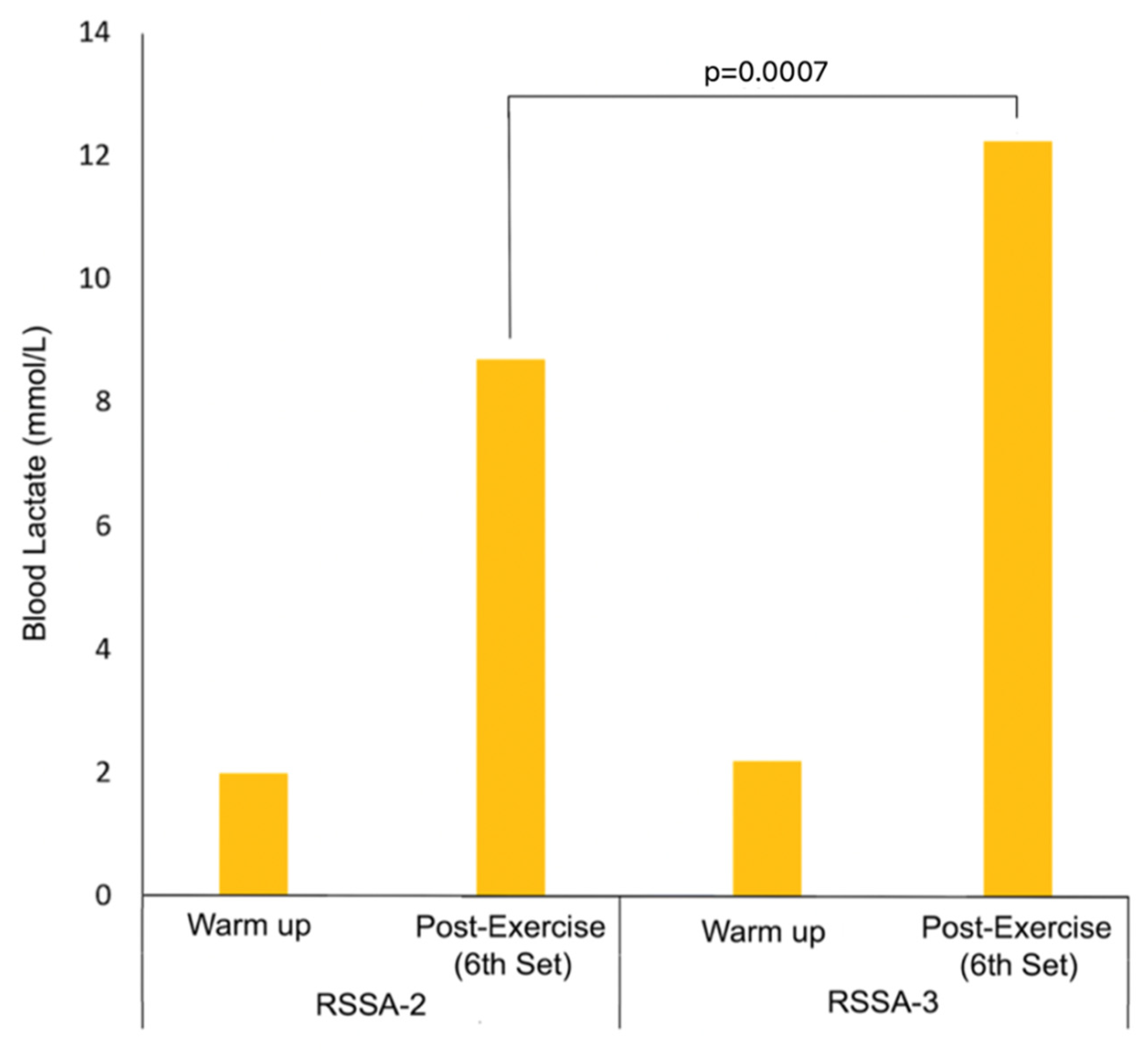
| Age (years) | Height (cm) | Weight (kg) | Body Fat (%) | Muscle Mass (kg) | Predicted VO2max (mL·kg−1·min) | HRmax (beats·min−1) |
|---|---|---|---|---|---|---|
| 22.65 ± 4.77 | 181.3 ± 4.2 | 81.5 ± 7.4 | 15.4 ± 3.9 | 39.5 ± 3.3 | 51.7 ± 4.2 | 197.2 ± 11.1 |
Publisher’s Note: MDPI stays neutral with regard to jurisdictional claims in published maps and institutional affiliations. |
© 2021 by the authors. Licensee MDPI, Basel, Switzerland. This article is an open access article distributed under the terms and conditions of the Creative Commons Attribution (CC BY) license (https://creativecommons.org/licenses/by/4.0/).
Share and Cite
Baron, J.; Gupta, S.; Bieniec, A.; Klich, G.; Gabrys, T.; Swinarew, A.S.; Svatora, K.; Stanula, A. Effect of Rest Period Duration between Sets of Repeated Sprint Skating Ability Test on the Skating Ability of Ice Hockey Players. Int. J. Environ. Res. Public Health 2021, 18, 10591. https://doi.org/10.3390/ijerph182010591
Baron J, Gupta S, Bieniec A, Klich G, Gabrys T, Swinarew AS, Svatora K, Stanula A. Effect of Rest Period Duration between Sets of Repeated Sprint Skating Ability Test on the Skating Ability of Ice Hockey Players. International Journal of Environmental Research and Public Health. 2021; 18(20):10591. https://doi.org/10.3390/ijerph182010591
Chicago/Turabian StyleBaron, Jakub, Subir Gupta, Anna Bieniec, Grzegorz Klich, Tomasz Gabrys, Andrzej Szymon Swinarew, Karel Svatora, and Arkadiusz Stanula. 2021. "Effect of Rest Period Duration between Sets of Repeated Sprint Skating Ability Test on the Skating Ability of Ice Hockey Players" International Journal of Environmental Research and Public Health 18, no. 20: 10591. https://doi.org/10.3390/ijerph182010591








